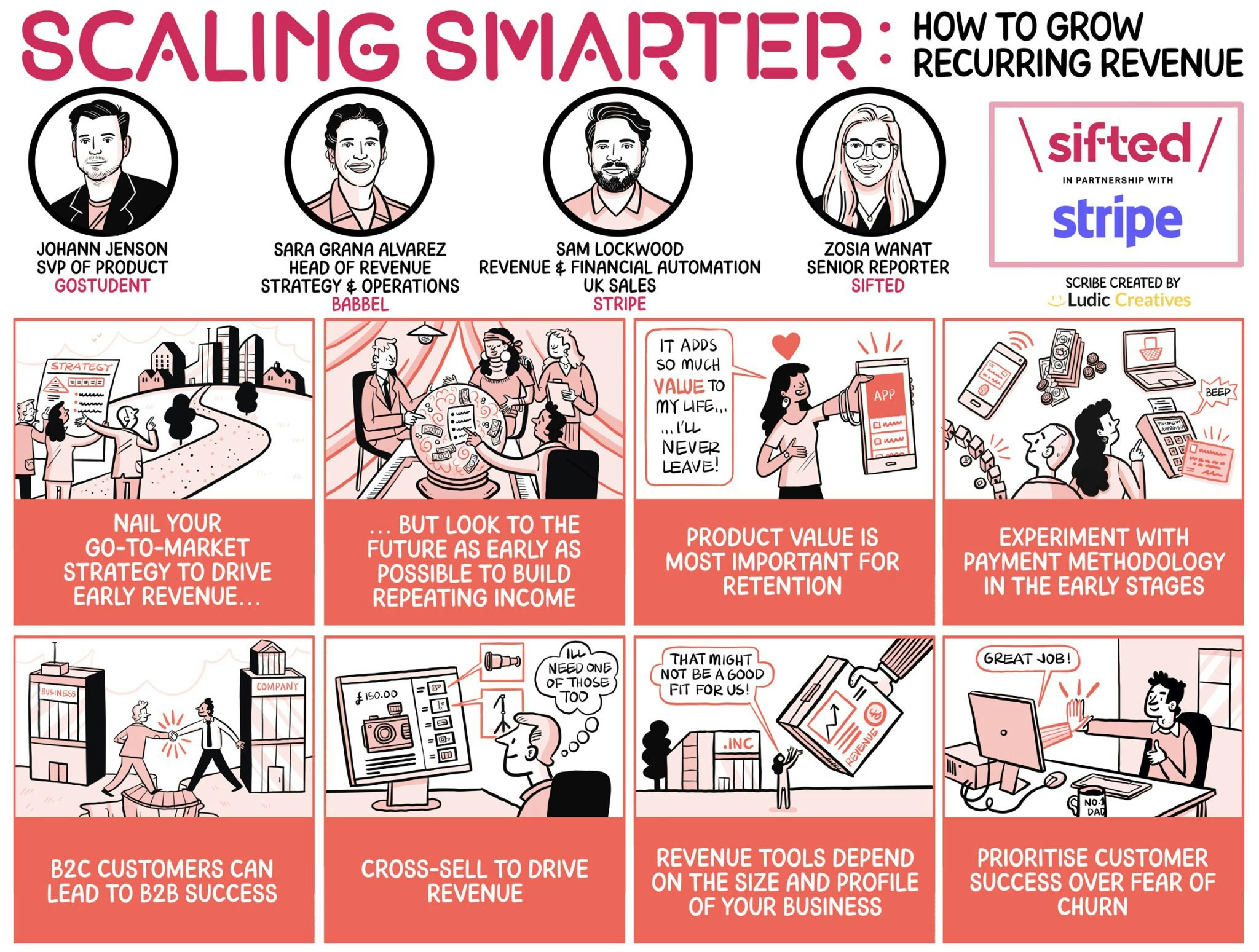Recurring revenue is the revenue that’s expected to continue in the future (like subscriptions) and in an uncertain economic climate, building it up can be an important step to stability.
But as startups grow, how do they make sure they retain their clients? Do B2B operations have to approach retention differently to customer-facing businesses? And how do you change your pricing strategy to keep your clients interested?
We put these questions to an expert panel, which included:
- Sara Grana Álvarez, head of revenue and strategy at language-learning platform Babbel
- Johann Jenson, senior vice president for product at tutoring platform GoStudent
- Sam Lockwood, revenue leads and sales automation expert at Stripe
Watch this Sifted Talks here or read about what we learnt:

1/ Nail your go-to-market strategy to drive early revenue
The conversation starts with the panel discussing the keys to driving early revenue. Álvarez says it’s never too early for startups to look into the future and think about how they will retain their first customers. With startups fighting for those first sales, many don’t consider how scaling will affect their future strategies.
Jenson stresses that product-market fit is vital in that early stage. Without a product that your clients want, it’s almost impossible to plan next steps.
Lockwood also points towards go-to-market strategy as integral to early-stage revenue. This helps startups find the right customers and then work on future retention strategies.
What is your go-to-market strategy? Who are you selling to and what type of sales experience do those customers have? That’s really going to often define the type of recurring revenue you as a business might have” — Sam Lockwood, Stripe
2/ Product value is vital for retention
Throughout the discussion, our panellists highlight the importance of product value in retaining customers. Jenson says that customers who are happy with the product become your ambassadors, delivering more clients in the long run.
Delivering this value can take different forms across the product and company. Lockwood highlights that AI is increasingly used to improve customer service, as poor support often leads to churn.
Álvarez points to constant optimisation of the product through customer feedback loops as an integral process for platforms like Babbel to improve.
If you’re not providing [customers] with value and they’re not passionate about what you’re offering them or you’re not changing people’s lives, you’re probably not going to drive retention” — Johann Jenson, GoStudent
3/ Revenue optimisation tools depend on the size of the company
When does a startup need to implement technology to help deliver and drive more revenue? And is there a specific model or suite of technology that can deliver optimal growth?
Lockwood stresses that this depends on the type of companies or customers you’re looking to engage. For high-touch companies that only require a small number of clients, it may not be important, but for companies looking to scale by rapidly expanding their customer base, creating automated and repeatable processes is vital.
Both Lockwood and Jenson agree that optimisation isn’t necessary until a base of clients is built up, with the flexibility of experimentation in payment methodology more important for very early-stage businesses.
If you’re a startup that needs thousands of clients to be successful because you’re only charging $1 a month then it’s going to be very difficult for you to do that fully manually without any automation” — Lockwood
4/ Startups can scale B2C brand awareness to B2B success
There remain key differences between revenue generation in B2B startups versus B2C. Álvarez says retention in customer-facing products is easier, as it’s just about driving value for a single customer, but B2B requires much more personalisation and clear alignment with the client’s goals.
However, with services like Babbel that offer both B2B and B2C versions of their product, having a swell of users asking their employer for access to a platform can create much larger potential revenue streams for startups.
You’ve built this relationship with them, they trust your brand, they trust what you’ve done… And those basket sizes are much larger” — Jenson
5/ Prioritise customer success over fear of churn
Startups will obviously want to minimise the number of people leaving their product. Our panel shares their tips for minimising churn.
Lockwood says A/B testing the “deflection process” — the steps taken to try and stop a customer from cancelling a subscription — is crucial, as it can throw up counter-intuitive results. He uses the example that often smaller discounts are better for retaining customers than large ones, as it doesn’t devalue the product.
Álvarez points out that customer success is more important than churn. She gives two examples. Babbel actually sees some churn as a positive reflection of the product, as it means customers have achieved their goal of learning a new language. Also, startups need not be afraid of reaching out to dormant customers for fear of losing revenue, as often it will remind customers of the value of the product rather than pushing them out the door.
Our North Star is learner success, which means that actually, to some extent, we want some churn. If people churn, they have learned the language… We look at it as voluntary versus involuntary, or happy churners versus unhappy churners” — Sara Grana Álvarez, Babbel
Like this and want more? Watch the full Sifted Talks here:


